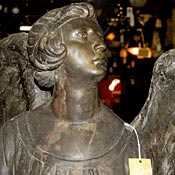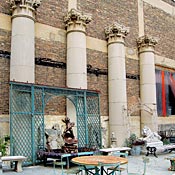>> Finder’s Keeper: A Go-To Guide
In the foyer of Architectural Artifacts, his 80,000-square-foot antiques and architectural elements store at 4325 North Ravenswood Avenue, Stuart Grannen is contemplating >>>
a table. To reach him, you have to walk past a French art deco glass door etched with an aquatic scene ($8,500), an Argentine wood pipe display stool ($4,500), and a four-foot-tall carved marble crucifix that was purchased today by the diocese of Omaha, Nebraska. There, next to an eight-foot-tall stone fireplace surround ($32,000), he stands beside a futuristic glass-and-steel table suitable for the Jetson family dining room.
“This isn’t really my style,” says Grannen, 49, as he studies the piece, a 1980s techno design similar to that of the English architect Norman Foster’s Nomos table. There is no price tag on the table yet; it has just arrived in the store, and now that it has been set up Grannen seems a bit unsure about it. “Do I even like this?” he asks. The contrast between Grannen and the sleekly contained Argentine table is strong-the table is a pristine slab of thick glass held aloft by a steel grasshopper-cum-gecko creature. Wearing shorts and sandals, and with his long, curly hair pulled back in a ponytail, Grannen resembles a cleaner, spiffed-up version of a 1960s hippie. And instead of sharp edges, there is an openness to both his face and his conversation. “OK, it’s growing on me,” he says, making a decision about the table. “We’ll see, but I think it’s growing on me.”
|
photography: Michael Monar
 |
For more than ten years, Grannen has been playing lost and found with antiques and architectural elements: terra cotta tiles, stained-glass doors and windows, iron porches from London townhouses, and even 22-foot-tall columns from the old Chicago Mercantile Exchange. He collects them, cleans them up, moves them into his vast store, and usually sells them. The exceptions are certain pieces (Frank Lloyd Wright windows, Louis Sullivan terra cotta) that he keeps for his museum of architecture, a work in progress located in the lower atrium of the store. “Stuart is a pioneer in the architectural recovery business,” says Tim Samuelson, the cultural historian of Chicago’s Department of Cultural Affairs. “He appreciates the artistic value of such fragments, and he’s gotten many other people to understand that value, too. Seeing the Chicago Mercantile columns he has erected at his store, you look up in wonder. But it also makes you a little sad that such architecture is being destroyed by society.”
Grannen’s crew, which varies from five to ten people depending on the scale of the job, goes out and removes parts of buildings before they are demolished, but Grannen doesn’t like the word “salvage” applied to his work. “Maybe that’s a little bit false on my part,” he says. “‘Salvage’ is a perfectly good word. But it’s not for me. I don’t want to say we’re better than that, but I also don’t want to get lumped in with a group of people who have buckets of old doorknobs sitting around in a dusty warehouse. I’m trying to give people a good product here.”
Despite its size, Architectural Artifacts does not bear much resemblance to a salvage warehouse, or even a regular antiques store. The place is bright and airy, thanks to the huge windows that are thrown open every day. Items are displayed artfully, rather than tossed together, and each has a manila tag attached with a hand-printed description, the price, and sometimes a comment. The tag on a marble bust reads, “Male torso-He’s Ripped-$465.” Another says, “English Victorian Inlaid Full Mantel-Killer-$16,000.” And the store is clean enough that Grannen does a nice side business renting it out for events.
“Everything he buys is high quality,” says Michael Del Piero, an interior designer at MJ Spear. Among the items that Del Piero has bought from Grannen over the years are a pair of steel-and-glass shelving units, 24 matching light fixtures, and an 18th-century santo. “And Stuart makes it effortless for the customer. He’s very pleasant with people, and if needed, he restores items to their original condition.”
|
photography: Kim Thornton
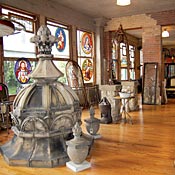 |
“I think of Stuart as an artist,” says Dorothy Mackevich Marks, a North Shore customer who has been buying from Grannen for more than ten years. “He just breathes new life into beautiful things,” she says. An example: pieces of an iron balcony that she bought and held onto for years, not knowing what to do with them. “When we renovated part of the house, they became the stair banister.”
Still, not everyone has been delighted with the reclamation of antique and vintage items by Grannen and his colleagues. His store’s recent selling of religious artifacts-altars and chalices from Catholic churches, a synagogue’s Ten Commandments stone-has irritated some people. When questioned about it last year, Grannen made a comment that hit the Associated Press wires: “I’m an equal opportunity seller.”
“Nobody needs any of this stuff,” says Grannen, sitting on an Argentine deco love seat on the second floor of Architectural Artifacts. “They just want it.” The buyers are dealers, designers, and homeowners, both local and out-of-state people. On a smaller scale, antique fireplace mantels from Grannen’s store have graced Ralph Lauren’s stores, and his ironwork objects have turned up in the pages of Architectural Digest. The top request is always doors, Grannen says: “wooden doors. Boring, but people need them because over the years, they were removed or got beaten up. Doors.” He drags the word out into several syllables, making it sound like a ridiculous request. “Personally, I hate doors.”
|
photography: Brittney Blair
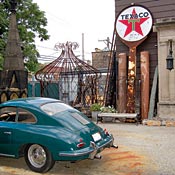 |
Over the years, Grannen has bought, renovated, and sold properties in Roscoe Village and Ravenswood. He is between homes now but is closing on a new building soon. In spite of his love for antiques, the style of his homes is always minimal and somewhat modern. “The one kind of place I could never live in is a Victorian house with lots of little rooms,” he says. Instead he likes wide-open spaces furnished sparely. “I once had just a bed and a chair in a 6,000-square-foot place. And no doors.” At home, he tends to remove even the doors to his bathrooms.
So door seekers usually have to go somewhere else. Other top requests from buyers include fireplaces, lighting, tiles, and “things people can make into a table base,” Grannen says. “Like a capital column. But those aren’t that easy to find anymore.”
The architectural salvage business sprang to life in the 1970s when there was a demand for Tiffany-style lights and stained-glass windows for restaurant décor. “It was places like T.G.I. Friday’s or Ruby Tuesday, the fern bars,” says Grannen. “People were taking bits and pieces and building a new Victorian look for commercial properties. The guys who got into that were about ten years older than me, generally old hippie guys. I was in the tail end of that-I was known as the youngest of the old guys-but I never liked doing that particularly. I wasn’t into the renovation angle of it all, or into making things look old. I like objects for what they are and how nice they look.”
In the past five years, architectural salvage stores have flourished beyond the biggest cities. “I used to be able to go to, say, Buffalo, and they would have saved everything for me,” Grannen says. “Now there are stores there doing the same thing.” Because of the competition, he turned to Europe, and when the dollar’s value fell there, he started buying in South America. Buenos Aires has become such a favorite spot that Grannen recently started a business there with the antiques dealer Guillermo Castro. When Grannen visits, he stays on the 70-foot 1920s yacht that he bought earlier this year.
“I guess there are some things here that are useful,” he says of the objects in his store, although he makes the word “useful” sound dubious. “Let me find something here.” He pauses, his look searching the contents of the vast second floor: marble cemetery angels, a 1940s children’s pedal plane, a midcentury mosaic coffee table once used in a Playboy photo shoot. “Boy, there’s not much here you really need,” he admits. “Well, fireplaces, light fixtures. But do you really need anything else that’s here? Not particularly. Life goes on without it. Maybe not as beautifully, but it does go on.”
|
photography: Brittney Blair
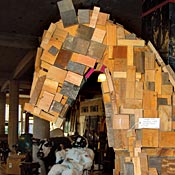 |
Grannen grew up in two towns in New Jersey, Livingston and Lake Valhalla. His father, James, was a chemical engineer and the president of a chemical company; his mother, Alta, was a homemaker. The couple shared an interest in collecting American furniture from the late 1700s to the early 1800s, and the family, which included Grannen’s older sisters, Sheila and Laura, frequently spent weekends at museums. “We didn’t go to Disneyland,” says Stuart. “We went to the Metropolitan Museum of Art, The Cloisters, The Breakers, and the big old Vanderbilt houses. So I was exposed to quality things, and I liked it. Not every day. There were times I wished I was playing baseball.”
In 1963, Jim Grannen quit smoking, and as an incentive, he took the money he would have spent on cigarettes and started collecting antique tools. So the family started visiting antique shops. “Whining wasn’t encouraged in our family,” says Sheila, a Chicago food stylist for photographers. “So we all developed our own interests. Mine was pewter.” Stuart bought his first stained-glass window when he was seven. “The big difference between us was that I was always selling some antique thing and using the money to buy shoes,” says Sheila. “Stuart would buy and sell, too, but he saved his money. He always kept his own counsel, too. We were not an emotionally-all-over-the-place family.”
In high school, Stuart became a top teen tennis player at the local country club. After he graduated in 1975, he went to the University of Tennessee in Knoxville, drawn by its archaeology department and its party-school atmosphere. He became fascinated by black studies after taking a freshman course in the subject and decided to make that a double major with archaeology. He also started poking around in the old houses of Knoxville, picking up a fireplace surround here, stained-glass windows there. In 1981, the year before the World’s Fair was held in Knoxville, miles of houses were razed for the fair site. “I had a field day,” Grannen says. “I bought everything I could and stored it in barns and warehouses. When the brother of my girlfriend at the time came to visit from New Orleans, he bought everything I had. Then he told me to come work for him.”
So Grannen moved to New Orleans in 1981 and started working in a huge antiques store called The Bank. He did not finish his degree because of what he calls “a misspent youth. I was wild with drinking, drugging, getting into trouble. That was just in Knoxville. And, well, New Orleans in the early eighties was not a great place to go if you were trying to get better. So I got worse, much worse. At 27, I lost my job, my money, and I had a heart attack from my behavior.”
“He was a mess,” says his sister Laura, a retired antiques dealer who is now a professional dog walker. In 1984, his family sent him to rehab at Hazelden in Minnesota.
|
photography: Brittney Blair |
| >> An 1880s life-size Italian angel in bronze and, in the garden at Architectural Artifacts, limestone columns from the 1927 Chicago Mercantile Exchange |
From the window in his room there, Grannen could see a wrecking company at work a few blocks away. “You were supposed to get a job during rehab, and everyone else there was working at McDonald’s. But I thought I was a hotshot and could do better.” So for two weeks, he went to the wrecking site and talked the crew into giving him “little bits and pieces of the building. I didn’t have any money, but within two weeks I sold everything to some antiques stores, paid the construction crew, and pocketed several hundred dollars. The hospital didn’t care for the whole thing.”
Eventually, Grannen sobered up-he has been straight now for 20 years-and after Hazelden, he stayed in Minneapolis. Within six months, he owned half of an architectural resale company. But the winters were too cold. Grannen moved to Nashville, where he continued buying and selling antiques and architectural details. He found himself buying more and more items in Chicago; in 1987, he moved here and rented a 3,000-square-foot operating space.
“There was just a wealth of stuff here in Chicago, so much stuff,” Grannen says. “Pretty soon the building was full, so I started letting people in on weekends.” In 1991, he bought “the little building”-previously it had housed a carnival trinket manufacturer-which is part of his space on Ravenswood today. About five or six years ago, he briefly thought about retiring, but then in 2002 he went in the opposite direction and bought the building next door to his store, the former Boye knitting needle factory. After a year of renovation, he unveiled the current 80,000-square-foot space, which includes a patio for marriage ceremonies and an atrium that has become a popular rental space for weddings, bar mitzvahs, and corporate events.
“I still have the addictive personality,” says Grannen. “When you get to go to a nice country and look at antiques and spend a lot of money, that’s just another addiction really. But this one is positive. Plus there’s a nice aesthetic to it.”
Even a former competitor is impressed. “Stuart is a hardworking, creative, great character,” says Leslie Hindman, an auctioneer who used to own Salvage One. “I have a huge amount of respect for him.”
On the back patio at Architectural Artifacts on a recent afternoon, Grannen was trying to eat lunch. His dog, Clayton, a 16-year-old Lab that is considered the store’s “number one employee,” is begging for chicken and salad croutons. Clayton is the mainstay in Grannen’s life, as his two chocolate Labs were before him. Grannen has never married and says he has no interest in doing so. “Funny you should ask, because I’ve been having this conversation for the last three days now with my girlfriend. I like the word ‘marriage’ about as much as I like the word ‘salvage.’ It’s fine for someone else but not for me.”
On one side of the patio, there are six columns from the Chicago Mercantile Exchange, which was torn down in 2003; on the other side is a forest green 1961 Porsche. The car is not for sale; Grannen uses it when he is not driving his 1958 ivory Porsche convertible.
|
photography: Brittney Blair |
“Buying the columns wasn’t really a good business decision,” says Grannen. “But how could we not do it? They were on the building; they were going to get wrecked. There were ten of them originally. So we paid $2,000 each and took them down ourselves, which cost about another $2,000 per column. I sold four to an antiques dealer in Napa, California. Then we put the rest of them up here, which cost another $2,000 each. But I couldn’t let them be destroyed.”
A couple in their 40s-wearing well-cut summer clothes and, despite the soaring heat, staying neatly groomed-wander out to the patio. “Holler if you have any questions,” says Grannen. The man does.
“What do you call this place?” he asks.
“It’s an antiques store,” says Grannen.
This answer gives the couple pause. Clearly Architectural Artifacts doesn’t fit their idea of an antiques store filled with china teapots and Victorian dressers. “What about that archway?” the woman asks, pointing to a large three-piece set of ironwork with suns in the corners and undulating iron rays. That launches Grannen into a story about dismantling an estate in DuPage County owned by a member of the Morton Salt family. The ironwork was part of the back portico of the house, and elk wandered into the yard while Grannen’s men were working. “How wonderful,” the woman says.
But there is still the controversy over the religious artifacts. “I went to Catholic schools for ten years, so I like to think it’s my re- venge,” Grannen says. “The truth is the Catholics always had great stuff. The Europeans came over here and tithed their money and used this Old World craftsman approach. About 12 years ago, the Chicago diocese got into some financial trouble, and they had to sell a lot of this stuff. And we sell a lot of it back to other churches.”
But didn’t an altar end up in a Las Vegas casino?
“Did that happen?” Grannen says. “Well, being a sinner boy, I don’t know that I care. I don’t think I’ve ever sold anything for an outright sacrilegious purpose. And I’m pretty sure that if a big black hearse pulled up and a bunch of people with pentagram tattoos and black hoods got out, I wouldn’t sell them any of the religious artifacts.”
Then there was the Detroit district attorney who wanted to arrest Grannen for possessing stolen property. The six stone lion heads came from a building being torn down in Detroit. Grannen bought the lion heads at a flea market in Ann Arbor, and then a Chicago developer purchased them from him and put them on a townhouse in Andersonville. “Someone recognized them as belonging to this building, which, by the way, no one in Detroit had tried to save. So I said, ‘If it matters to you that much, I know how to get the rest of them,’ and I contacted six Michigan antiques dealers, collected 24 lions, and turned them over to the cops.”
“Yes, he gave us back some of the lion heads, and in exchange we agreed not to prosecute him,” says Dennis Doherty, an assistant prosecuting attorney for Wayne County, Michigan. “We are done with that case.”
“Here’s the lesson from that for everyone,” Grannen says. “If you are that upset about losing something, then take care of it. Take care of the stuff you want to save.”
It has been a good week at Architectural Artifacts. Extra terra cotta from the Carson Pirie Scott building that cannot be used in the restoration has come in, as well as a finial from the Wrigley Building (18 years ago, the originals were disposed of and replaced with fiberglass replicas), part of Louis Sullivan’s Garrick Theatre from the estate of an architect, some stained glass, and a shipment from France. The modern glass-and-steel table now has a price tag: $3,800. It also appears to have a buyer. “We’ll see,” says Grannen, echoing what he said when he first studied the table in his store. “Someone said he wants it, but you know how that goes.”
The ebb and flow of merchandise is second nature to Grannen by now. There is always something great to save right around the corner and always someone to sell it to. “The antiques business is full of nut cases, and I guess I’m one of them,” he says. “Whether I’m nuttier or a little less nutty, somehow it all works-which is good, because for me, it’s my life and breath.”



